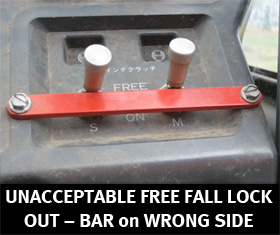Mobile cranes with a free fall feature
Issued: 9 March 2012
Last Updated: 9 March 2012
Purpose
The purpose of this safety alert is to highlight the importance of correctly locking out the free fall controls on mobile cranes fitted with this feature.
Background
A worker was fatally injured by a falling load while erecting a transmission tower west of Dalby in Queensland in March 2012. A 20 tonne rough terrain mobile crane was being used to lift part of the tower when it appears the auxiliary winch inadvertently went into free fall and the load fell, striking the worker.
Hoist winches on some mobile cranes are fitted with a free fall feature that allows the hook and load to fall under gravity in an uncontrolled manner. This feature has been traditionally provided on cranes for activities such as clam-shell dredging and dynamic compaction. However, the risk associated with an inadvertent activation of the free fall feature can be high and the provision is rarely needed. Most mobile crane manufacturers do not provide this feature on new cranes. The risk to workers from falling loads and potential damage to the crane and crane operator is too great to continue to allow free fall on cranes as standard industry practice.
To prevent inadvertent activation of the free fall feature, it is a common practice for crane owners to install a physical lock. Unfortunately, some of the physical lock arrangements have not been effectively installed. Errors have been made when interpreting the operation of the free fall switching mechanism. Photograph 1 shows one example of the physical lock being fitted to the wrong side of the switch. In this example the crane may inadvertently go into free fall if the hoist brake pedal on the crane is depressed.

Photograph 1 - Photograph shows an incorrect arrangement of the physical lock on a Tadano TR 200M-5 mobile crane to prevent inadvertent activation of the free fall mechanism where the metal bar has been placed on the wrong side of the switches.
Remedial action required
This incident has highlighted the need for the cranes to be operated so that inadvertent free fall of the load cannot occur. Workplace Health and Safety Queensland (WHSQ) considers that the following action should be taken by all owners of mobile cranes in Queensland:
1. Immediate action:
- Owners of cranes with free fall features, that do not have a physical lockout arrangement to prevent inadvertent activation, are to engage a competent person to install a lockout and test the arrangement.
- Owners of cranes with a free fall lockout on the crane are to engage a competent person to inspect and test to ensure that the lock out has been correctly installed and free fall cannot be inadvertently activated.
The test of the free fall function (while the lock is installed) is to verify that free fall cannot be inadvertently activated. The test is to be carried out in a controlled environment where people cannot be injured and the crane cannot be damaged. A signed, written record of the test is to be provided on the crane.
2. Action within six months:
- Owners of any crane with free fall capabilities should consider de-activating the free fall facility permanently unless there are no alternatives for this type of operation. A documented risk assessment should be prepared for this situation. This de-activation of the free fall should include removal of free fall switches on the crane and a certificate from the crane manufacturer or a competent person (preferably a professional engineer) to state that the free fall function has been permanently removed.
The following additional information should also be noted:
- Workers should avoid being located under the suspended loads.
- The use of the free fall function on a mobile crane should be extremely rare and only be permitted where a documented safe work method statement has shown there is no other reasonable alternative.
- Free fall operation on a mobile crane should never be carried out with people any where near the lift zone.